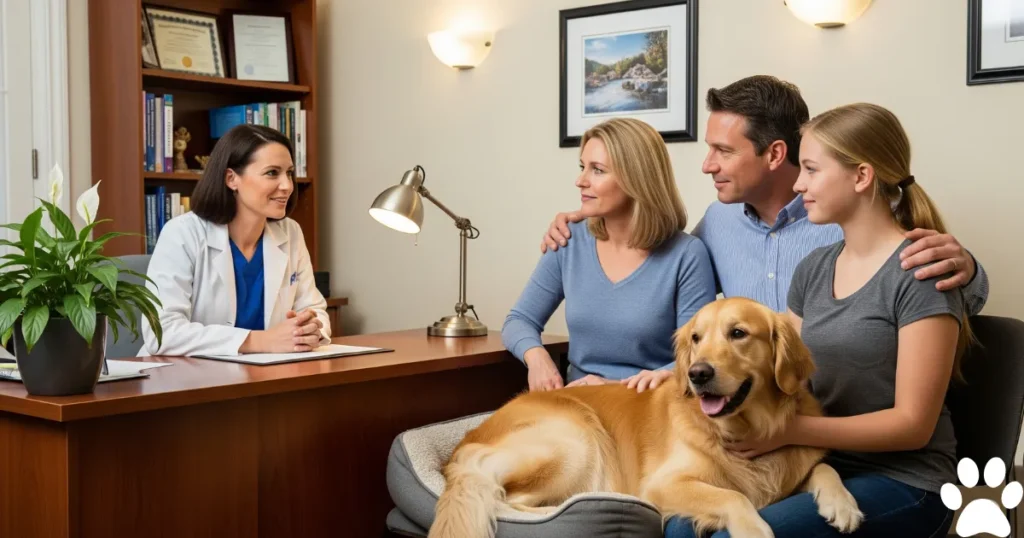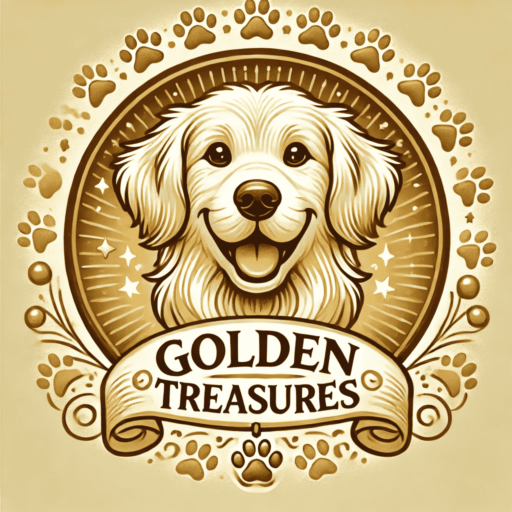Facing the final stages of osteosarcoma in dogs is one of the most heartbreaking experiences a Golden Retriever owner can endure. Osteosaoma, commonly known as bone cancer, is an aggressive malignancy that particularly affects large breed dogs like Golden Retrievers, often requiring difficult decisions about end-of-life care and comfort measures.
Understanding what to expect during the final stages of osteosarcoma in dogs helps owners provide the best possible care while making informed decisions about their beloved companion’s quality of life. This comprehensive guide offers compassionate, practical information to help Golden Retriever families navigate this challenging journey with dignity and love.
While this information may be difficult to read, knowledge empowers owners to recognize when their Golden Retriever is approaching the end stages of this disease, allowing for appropriate comfort care and meaningful time together during their final weeks or months.
Contents
- 1 Understanding Osteosarcoma in Golden Retrievers
- 2 Recognizing the Final Stages of Osteosarcoma in Dogs
- 3 Pain Management and Comfort During Final Stages
- 4 Metastatic Disease Complications
- 5 Quality of Life Assessment
- 6 End-of-Life Care Options
- 7 Making Difficult Decisions
- 8 Supporting Your Golden Retriever’s Final Journey
- 8.1 Maintaining Dignity and Comfort
- 8.2 Family Support and Grief Processing
- 8.3 How long do dogs typically survive in the final stages of osteosarcoma?
- 8.4 What are the most obvious signs that my Golden Retriever is in the final stages?
- 8.5 Can pain be adequately controlled during end-stage osteosarcoma?
- 8.6 Should I consider amputation during the final stages?
- 8.7 How do I know if my Golden Retriever is suffering?
- 8.8 What should I expect during the final weeks?
- 8.9 Is it better to euthanize at home or at the veterinary clinic?
- 8.10 How can I prepare my family for the loss?
- 9 Final Thoughts
Understanding Osteosarcoma in Golden Retrievers
Osteosarcoma represents the most common primary bone tumor in dogs, with Golden Retrievers being among the breeds at highest risk due to their size and genetic predisposition. This aggressive cancer typically develops in the long bones of the limbs, though it can occur in other skeletal locations including the ribs, skull, and spine.
The disease progresses through distinct stages, from initial tumor development through metastasis and eventual end-stage complications. Final stages of osteosarcoma in dogs are characterized by widespread cancer spread, severe pain, and declining organ function that significantly impacts quality of life.
Golden Retrievers diagnosed with osteosarcoma face unique challenges due to their typically active lifestyle and strong bond with their families. The contrast between their normally energetic nature and the limitations imposed by advanced bone cancer can be particularly distressing for both dogs and their owners. Early recognition of osteosarcoma symptoms is crucial, as this knowledge helps owners understand the disease progression and prepare for the challenges ahead.
Recognizing the Final Stages of Osteosarcoma in Dogs
Physical Deterioration Signs
During the final stages of osteosarcoma in dogs, physical symptoms become increasingly severe and difficult to manage with standard pain relief measures. Golden Retrievers in end-stage osteosarcoma typically exhibit profound physical changes that indicate the cancer’s advanced progression.
The most noticeable physical signs include:
- Severe lameness that progresses to inability to bear weight on the affected limb
- Visible swelling and deformity at the tumor site
- Pathological fractures that occur with minimal trauma
- Extreme difficulty rising, walking, or maintaining balance
- Rapid weight loss and muscle wasting despite nutritional support
- Labored breathing due to lung metastases
These physical changes often develop rapidly during the final weeks, as the primary tumor continues growing while metastatic disease spreads throughout the body. The combination of local bone destruction and systemic cancer effects creates a cascade of complications that become increasingly difficult to manage.
Behavioral and Mobility Changes
Final stages of osteosarcoma in dogs profoundly affect behavior and mobility patterns in Golden Retrievers. Dogs who were once active and social may become withdrawn, reluctant to move, and disinterested in activities they previously enjoyed.
Behavioral indicators of end-stage disease include:
- Reluctance or inability to participate in normal activities
- Spending most of the day lying down or sleeping
- Loss of interest in food, treats, or social interaction
- Difficulty finding comfortable positions for rest
- Increased vocalization due to pain or discomfort
- Changes in bathroom habits due to mobility limitations
Golden Retrievers are naturally social and active dogs, making these behavioral changes particularly noticeable to their families. The stark contrast between their normal personality and end-stage limitations often serves as a clear indicator that the disease has progressed significantly.

Pain Management and Comfort During Final Stages
Understanding Pain Levels
Pain management becomes the primary focus during the final stages of osteosarcoma in dogs. Golden Retrievers with advanced osteosarcoma experience multiple types of pain, including bone pain from tumor growth, nerve pain from tissue compression, and referred pain from compensatory movements.
Pain indicators in end-stage Golden Retrievers include:
- Persistent panting, especially when at rest
- Reluctance to move or change positions
- Trembling or shaking
- Loss of appetite
- Restlessness or inability to settle comfortably
- Increased aggression or withdrawal when touched
Effective pain assessment requires careful observation of subtle changes in behavior, breathing patterns, and body language. Golden Retrievers often hide their discomfort, making it crucial for owners to recognize early signs of inadequate pain control.
Medication Options and Limitations
Managing pain during the final stages of osteosarcoma in dogs requires a multimodal approach combining various medications and therapies. However, advanced disease often challenges even aggressive pain management protocols.
Common pain management strategies include:
- Strong opioid medications for severe bone pain
- Anti-inflammatory drugs when kidney function permits
- Nerve blocks for localized pain relief
- Gabapentin for neuropathic pain
- Tramadol for moderate pain management
- Complementary therapies like acupuncture or massage
As the disease progresses, medication effectiveness may diminish while side effects become more problematic. Kidney and liver function decline can limit medication options, creating challenging situations where pain control becomes increasingly difficult to achieve Golden Retriever Health.

Metastatic Disease Complications
Lung Metastases Effects
The final stages of osteosarcoma in dogs frequently involve pulmonary metastases, as bone cancer cells spread through the bloodstream to establish secondary tumors in the lungs. This complication significantly impacts breathing and overall comfort in Golden Retrievers.
Pulmonary metastases cause:
- Progressive difficulty breathing, especially during activity
- Persistent coughing that may produce blood
- Reduced exercise tolerance and increased fatigue
- Blue or pale gums indicating poor oxygen circulation
- Restlessness due to breathing discomfort
- Preference for sitting or standing rather than lying down
Lung metastases develop in approximately 90% of dogs with osteosarcoma, making respiratory complications nearly inevitable during the final stages. The extent of lung involvement directly correlates with breathing difficulties and overall quality of life.
Other Organ System Involvement
Beyond lung metastases, the final stages of osteosarcoma in dogs may involve spread to other organs including the liver, kidneys, and additional bones. This widespread disease creates multiple systemic complications that compound the challenges of end-stage care.
Multi-organ involvement can cause:
- Liver dysfunction affecting digestion and medication processing
- Kidney problems limiting pain medication options
- Additional bone lesions causing widespread pain
- Neurological symptoms if the spine is affected
- Digestive issues including nausea and appetite loss
- General weakness and systemic illness
Quality of Life Assessment
Mobility and Independence Evaluation
Assessing quality of life during the final stages of osteosarcoma in dogs requires honest evaluation of your Golden Retriever’s ability to maintain basic functions and enjoy simple pleasures. Mobility serves as a crucial indicator, as severe limitations significantly impact overall wellbeing.
Key mobility factors to evaluate:
- Ability to rise without assistance
- Willingness to walk short distances
- Capacity to reach food, water, and bathroom areas
- Comfort when lying down or changing positions
- Interest in going outside or exploring
- Ability to interact with family members
Golden Retrievers naturally desire to please their families and may attempt activities beyond their capabilities. Careful observation helps distinguish between determined effort and genuine comfort with movement.
Pain vs. Pleasure Balance
The final stages of osteosarcoma in dogs require continuous evaluation of the balance between pain and pleasure in your Golden Retriever’s daily experience. This assessment guides decisions about continued treatment versus compassionate end-of-life care.
Consider these quality of life indicators:
- More good days than bad days
- Interest in favorite foods or treats
- Response to family interaction and affection
- Ability to rest comfortably
- Participation in preferred activities, even briefly
- Overall demeanor and personality retention
Many veterinarians recommend using quality of life scales that assign numerical values to various factors, helping owners make objective assessments about their dog’s wellbeing during this difficult time.

End-of-Life Care Options
Home Comfort Care
Providing comfort care at home during the final stages of osteosarcoma in dogs allows Golden Retrievers to remain in familiar surroundings with their beloved families. This approach focuses on maximizing comfort and maintaining dignity while managing symptoms.
Home comfort care includes:
- Soft bedding and orthopedic support to reduce pressure points
- Easy access to food, water, and bathroom areas
- Temperature control for optimal comfort
- Gentle massage and physical therapy as tolerated
- Maintaining routine and familiar schedules when possible
- Providing emotional support and companionship
Creating a comfortable environment requires modifications to accommodate reduced mobility while preserving as much normalcy as possible. Many Golden Retrievers find comfort in maintaining proximity to their families during their final weeks.
Hospice and Palliative Care Services
Veterinary hospice and palliative care services provide specialized support for families navigating the final stages of osteosarcoma in dogs. These services focus on comfort, pain management, and quality of life rather than curative treatment.
Professional hospice care offers:
- Regular veterinary visits for pain assessment and medication adjustment
- 24-hour consultation availability for urgent concerns
- Guidance on comfort care techniques and environmental modifications
- Emotional support for family members
- Assistance with end-of-life decision making
- Coordination of euthanasia services when appropriate
These specialized services help ensure that Golden Retrievers receive optimal comfort care while supporting families through this challenging journey.

Making Difficult Decisions
Recognizing When It’s Time
Determining when to consider euthanasia during the final stages of osteosarcoma in dogs represents one of the most difficult decisions pet owners face. The goal is preventing suffering while honoring the special bond shared with your Golden Retriever.
Consider euthanasia when:
- Pain can not be adequately controlled despite maximum medication
- Your dog shows no interest in food, water, or interaction
- Breathing becomes severely labored or distressed
- Mobility is completely lost and comfort can not be maintained
- More bad days than good days occur consistently
- Your Golden Retriever’s personality and spirit seem absent
The decision ultimately rests with the family, guided by veterinary assessment and careful observation of the dog’s quality of life. There is no universally “right” time, but preventing unnecessary suffering should guide the decision-making process.
Euthanasia Considerations
When the final stages of osteosarcoma in dogs progress to the point where comfort can not be maintained, euthanasia provides a peaceful, dignified end to suffering. This difficult decision reflects love and compassion for your Golden Retriever’s wellbeing.
Euthanasia planning considerations include:
- Location preferences (home, veterinary clinic, or specialized facility).
- Family members who wish to be present.
- Special rituals or preparations that provide comfort.
- Aftercare arrangements for your dog’s remains.
- Memorialization plans to honor your companion’s memory.
- Support resources for grief processing.
Many families find comfort in planning these details in advance, allowing them to focus on saying goodbye and honoring their Golden Retriever’s life during the final moments.

Supporting Your Golden Retriever’s Final Journey
Maintaining Dignity and Comfort
Throughout the final stages of osteosarcoma in dogs, maintaining your Golden Retriever’s dignity becomes as important as managing physical symptoms. This involves preserving their sense of security and connection to family while adapting care to their changing needs.
Dignity preservation includes:
- Maintaining cleanliness and grooming as tolerated.
- Preserving normal routines and schedules when possible.
- Continuing gentle physical affection and interaction.
- Respecting your dog’s preferences for rest and activity.
- Avoiding invasive procedures that don’t improve comfort.
- Honoring their role as a beloved family member.
Golden Retrievers maintain their loving nature even during illness, and reciprocating that love through respectful, compassionate care honors the special bond you share.
Family Support and Grief Processing
The final stages of osteosarcoma in dogs affect entire families, requiring emotional support for all members as they prepare to say goodbye to their beloved Golden Retriever. Acknowledging grief and seeking appropriate support benefits everyone involved.
- Family support strategies include:
- Open communication about the dog’s condition and prognosis.
- Involving children in age-appropriate ways.
- Seeking counseling or support groups for pet loss.
- Creating meaningful memories and keepsakes.
- Honoring the dog’s contribution to family life.
- Planning memorial services or tributes.
Professional counseling, pet loss support groups, and veterinary social workers can provide valuable guidance during this difficult time.

How long do dogs typically survive in the final stages of osteosarcoma?
The final stages of osteosarcoma in dogs can last from several weeks to a few months, depending on factors like metastatic spread, pain control effectiveness, and individual response to treatment. Golden Retrievers with advanced disease typically survive 1-4 months with comfort care, though some may have shorter or longer timelines.
What are the most obvious signs that my Golden Retriever is in the final stages?
The most obvious signs of final stages of osteosarcoma in dogs include severe lameness or inability to walk, extreme difficulty breathing, complete loss of appetite, inability to find comfortable positions, and withdrawal from family interaction. These symptoms typically indicate that the cancer has progressed significantly.
Can pain be adequately controlled during end-stage osteosarcoma?
Pain control during final stages of osteosarcoma in dogs becomes increasingly challenging as the disease progresses. While many dogs achieve good comfort initially, advanced bone cancer often requires maximum pain medications, and some dogs eventually reach a point where adequate pain relief becomes difficult to maintain.
Should I consider amputation during the final stages?
Amputation during final stages of osteosarcoma in dogs is rarely recommended, as advanced disease typically involves metastatic spread that limits the procedure’s benefits. Most veterinarians focus on comfort care rather than surgical interventions when dogs reach end-stage disease.
How do I know if my Golden Retriever is suffering?
Signs of suffering during final stages of osteosarcoma in dogs include persistent panting, inability to rest comfortably, loss of interest in all activities, difficulty breathing, and changes in personality or behavior that suggest distress. Quality of life scales can help assess suffering levels objectively.
What should I expect during the final weeks?
During the final weeks of final stages of osteosarcoma in dogs, expect progressive weakness, increased sleep, decreased appetite, and difficulty with mobility. Many Golden Retrievers become increasingly dependent on their families for basic needs while showing decreased interest in their surroundings.
Is it better to euthanize at home or at the veterinary clinic?
The choice between home and clinic euthanasia during final stages of osteosarcoma in dogs depends on your Golden Retriever’s comfort level, family preferences, and practical considerations. Many dogs are more relaxed at home, while others may be less stressed in familiar medical environments. Discuss options with your veterinarian.
How can I prepare my family for the loss?
Preparing for loss during final stages of osteosarcoma in dogs involves open communication about the dog’s condition, creating lasting memories, discussing end-of-life decisions as a family, and seeking support resources for grief processing. Professional counseling can help families navigate this difficult transition.
Final Thoughts
Navigating the final stages of osteosarcoma in dogs requires immense courage, compassion, and dedication from Golden Retriever families. While this journey is undeniably difficult, understanding what to expect allows owners to provide the best possible comfort care while making informed decisions about their beloved companion’s wellbeing.
Remember that every Golden Retriever’s experience with end-stage osteosarcoma is unique, and your dog’s timeline and symptoms may differ from typical patterns. The most important consideration is maintaining quality of life and preventing unnecessary suffering while honoring the special bond you share.
Throughout the final stages of osteosarcoma in dogs, focus on love, comfort, and dignity. Your presence, care, and devotion provide immeasurable comfort to your Golden Retriever during their final journey. While saying goodbye is heartbreaking, the love and memories you’ve shared will endure long after your companion is gone.
Trust your instincts as a loving pet owner, work closely with your veterinary team, and make decisions based on your Golden Retriever’s individual needs and quality of life. The courage to face this difficult time with compassion reflects the deep love that defines the human-canine bond.
Dr. Nabeel A.
Hi, I’m Dr. Nabeel Akram – a farm management professional by trade and a passionate Golden Retriever enthusiast at heart. With years of experience in animal science and livestock care, I’ve built a career around understanding animals—how they live, thrive, and bring value to our lives. This blog is a personal project born from that same passion, focusing on one of the most loyal and lovable breeds out there: the Golden Retriever. Whether I’m managing farm operations or sharing insights on canine health, behavior, and care, it all ties back to one core belief—animals deserve thoughtful, informed, and compassionate attention. Welcome to a space where professional expertise meets genuine love for dogs.
Facebook |


Links will be automatically removed from comments.